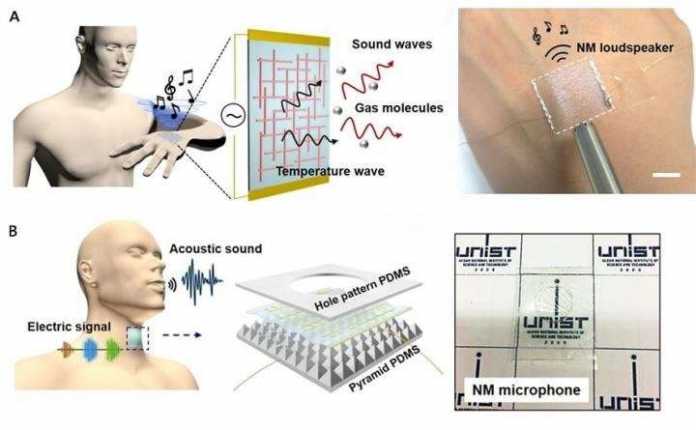A group of international scientists affiliated with the UNIST have developed an ultrathin, transparent wearable device that can convert the user’s skin into a loudspeaker. The device was partially created to help the hearing and speech impaired.
In their research, the team developed ultrathin, transparent and conductive hybrid nanomembranes with a nanoscale thickness that consists of an orthogonal silver nanowire array embedded in a polymer matrix. The nanomembrane was then used as a loudspeaker that can be attached to almost anything to produce sounds. The researchers also introduced a similar device, acting as a microphone, that can be connected to smartphones and computers to unlock voice-activated security systems.
Nanomembranes are separation layers with nanoscale thickness. Despite their flexibility, lightweight, and high adhesiveness, they can tear very easily and have no electrical conductivity, which posed a great challenge to the scientists. This was solved by embedding a silver nanowire network within a polymer-based neuromembrane, which enabled the demonstration of skin-attachable and imperceptible loudspeaker and microphone.
Saewong Kang, the author of the first study said, “Our ultrathin, transparent, and conductive hybrid NMs facilitate conformal contact with curvilinear and dynamic surfaces without any cracking or rupture. These layers are capable of detecting sounds and vocal vibrations produced by the triboelectric voltage signals corresponding to sounds, which could be further explored for various potential applications, such as sound input/output devices.”
The research team fabricated skin-attachable NM loudspeakers and microphones using the hybrid NMs. These wearable speakers and microphones are paper-thin, yet still capable of conducting sound signals. “The biggest breakthrough of our research is the development of ultrathin, transparent, and conductive hybrid nanomembranes with nanoscale thickness, less than 100 nanometers,” said Prof. Hyunhyub Ko, from UNIST. “These outstanding optical, electrical, and mechanical properties of nanomembranes enable the demonstration of skin-attachable and imperceptible loudspeaker and microphone,” he added.
How it works is that these skin-attached NM loudspeakers emit thermoacoustic sounds by the temperature-induced oscillations of the surrounding air. These oscillations are caused due to the periodic Joule heating that occurs when an electric current passes through a conductor and produces heat.
Wearable microphones are sensors attached to a speaker’s neck to even sense the vibration of the vocal folds. This sensor operates by converting the frictional force generated by the oscillation of the transparent conductive nanofiber into electric energy. The hybrid nanomembrane is inserted between elastic films with tiny patterns to precisely detect the sound and the vibration of the vocal cords based on a triboelectric voltage that results from the contact with the elastic films.
Says Professor Ko, “For commercial applications, the mechanical durability of nanomebranes and the performance of loudspeaker and microphone should be imp0roved further”. This new technology can also be used for applications such as IOT (Internet Of Things) Censors and conformal healthcare devices.




























